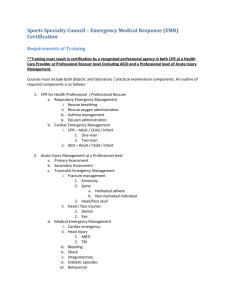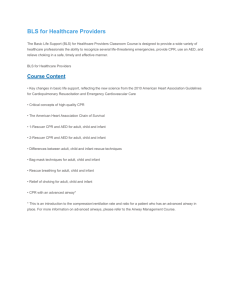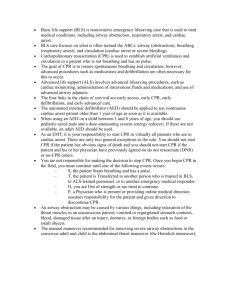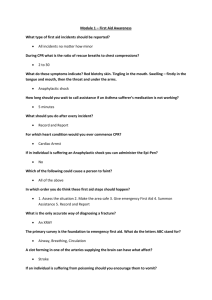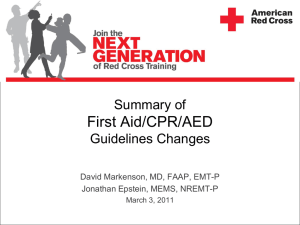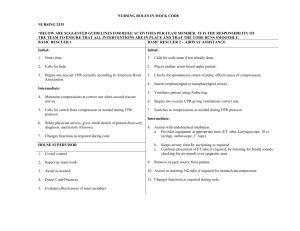Aucun titre de diapositive
advertisement
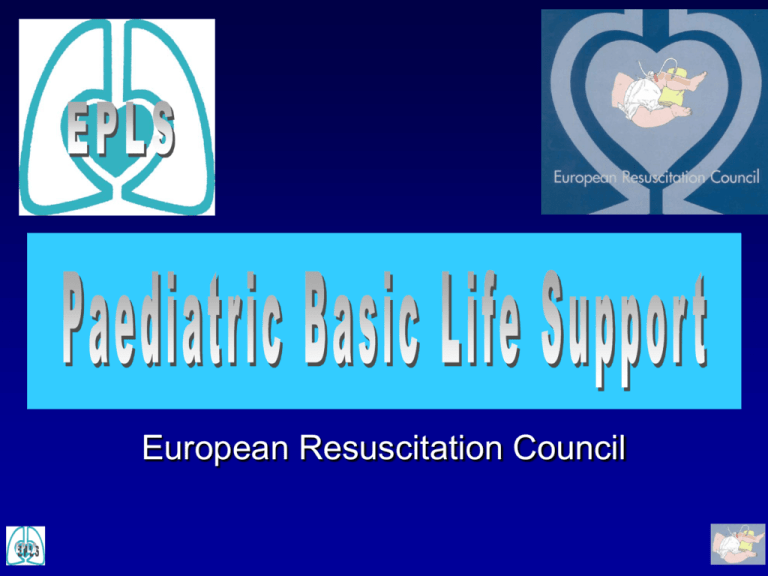
European Resuscitation Council Summary Causes of cardiorespiratory arrest BLS sequence in paediatrics AED in children Foreign body airway obstruction relieve BLS Recognition of a person in cardiac or respiratory arrest Delivery of oxygen to vital organs by CPR Without the use of adjuncts Paediatric cardiorespiratory arrest Secondary to hypoxia, acidosis, inappropriate perfusion Terminal Rhythm: Bradycardia, Pulseless Electrical Activity → Asystole Out-of-hospital arrest is « hypoxic and hypercapnic with respiratory arrest preceding asystolic cardiac arrest» Comparison with adult arrest Ventricular Fibrillation in children is more rare than in adult 6-9% to 15-24% (SIDS excl) of cardiac arrest Secondary to metabolic anomaly : 4H/4T Hypothermia Hypoxia Hyper/hypokalaemia Hypovolaemia Tamponade Toxics - drugs Thrombo-embolism Tension-pneumothorax Activation of the EMS system In child less than 8 years All: Drowning, Trauma, Poisonning Single rescuer summons help (EMS) after one minute of BLS “call fast” Activation of the EMS system In child older than 8 years All: Witnessed sudden collapse, Known cardiopathy Single rescuer summons help (EMS) immediately to provide rapid access to AED “call first” Safety Ensure rescuer’s safety first Then ensure victim’s safety (even trauma) Use barrier devices (infectious diseases) Look for clues of what has caused the emergency Stimulate Establish responsiveness Never shake a child Tactile stimulation • Maintaining C-spine (stabilise forehead) • Shake arm or tug hair Verbal stimulation • Child’s name • “Wake up” • “Are you alright” Shout for assistance Single rescuer: shouts for help while remaining with the child and starts CPR Multiple rescuers: one rescuer provides BLS while one rescuer activates EMS system Airway To open the airway, lift the tongue that occludes the AW by Head tilt-chin lift Neutral position More head extension Airway To open the airway, lift the tongue that occludes the AW by Jaw thrust Checking the airway Look into the mouth Ensure no foreign body is present Remove with ONE gentle finger sweep Avoid blind finger sweep (further impaction, soft tissue damage) Breathing Check breathing: Look, Listen, Feel For up to10 seconds If the child Is breathing spontaneously and effectively Maintain AW Summon help Place in recovery position Has no detectable, spontaneous, effective breathing Deliver rescue breaths Rescue Breaths Deliver up to 5 breaths to ensure 2 effective Slow breath : 1 to 1.5 second each Minimise gastric distension Optimise oxygen delivered Deep rescuer’s breath between each rescue breath Optimise amount of oxygen Minimise amount of expired CO2 Rescue Breaths Mouth-to-mouth and nose technique Rescue Breaths Mouth-to-mouth technique Circulation Assess for signs of circulation For up to 10 seconds Pulse Brachial or femoral pulse in infant Carotid pulse in child Signs of life Cough Movement Normal breathing (no gasp) If signs of circulation are Found Reassess breathing Give rescue breaths (20 cpm) Reassess Absent or pulse is very slow + poor perfusion Deliver external chest compression Depress 1/3 to ½ of A/P Ø thorax Rate : 100/min (actual 60-80 min) Ratio : 5 compressions for 1 rescue breath Circulation ECC in Infant Two-fingers technique Two-thumbs technique Circulation ECC in Child < 8 years Circulation ECC in Child > 8 years Ratio 15:2 Reassess ECC produces a palpable central pulse Reassess briefly after one minute and summon help Continue CPR non-stop Activate EMS System Take the child with you to continue CPR Informations Detailed location, phone number Type of accident, number and age of victims Severity and urgency (ALS) Confirm reception of message Duration of CPR ROSC and spontaneous respiration Qualified team arrives Rescuer exhausted Automated External Defibrillator (AED) Evaluates the victim’s ECG Determines if a “shockable” rhythm is present Charges the “appropriate” dose When activated by operator, delivers a shock Provides synthesised voice prompts to assist the operator AED in children? Class Indeterminate recommendation in children < 8 years Recommended (Class IIb) for children older than 8 years in the pre-hospital setting (ILCOR 2000) Most arrests in young children are of respiratory origin In this class of age arrests rhythms are mainly asystole and PEA VF may occur in up to 25% of cardiac arrest when SIDS are excluded Prompt defibrillation is the definitive treatment for VF and pulseless VT CPR remains the most important step of Paeds-BLS Recommendation (Circulation 2003; July) ILCOR consensus statement for AED in children May be used for children 1-8 years of age with no signs of circulation Should deliver a child dose Arrhythmia detection algorithm with high specificity for paediatric shockable rhythms (i.e not recommend shock delivery for non-shockable rhythms) Insufficient evidence to support recommendation for or against the use of AEDs in children < 1 year of age For single rescuer, 1 minute of CPR before any other action (i.e. activating EMS or AED attachment) Defibrillation is recommended for documented VF/pulseless VT. (Class I) FBAO in conscious victim Assess Airway 5 Chest Thrusts INFANT 5 Back Blows Assess Airway Assess breathing adequacy If conscious level deteriorated Unconscious FBAO Algorithm CHILD 5 Back Blows 5 Abdominal Thrusts FBAO in unresponsive child Unconscious Victim Attempt 5 Rescue Breaths Open Airway 5 Back Blows Check mouth 5 Chest Thrusts Unable to achieve chest movements on 5 attempts of breaths Attempt 5 Rescue Breaths Open Airway 5 Back Blows Check mouth 5 Chest thrusts 5 Abdominal Thrusts Recovery position To avoid the back-fall of the tongue in the pharynx and hence obstruction of AW To avoid risk of aspiration of vomit, secretions… Recovery position Principles As near a true lateral position as possible Patent airway maintained Child easily observed and monitored Child stable cannot roll over Free drainage of vomit/secretion No pressure on chest (impeding breathing) Can be turn easily on their back for BLS Conclusions We discuss about… • Results of BLS • Sequence of Paeds-BLS • Use of AED in children • FBAO
